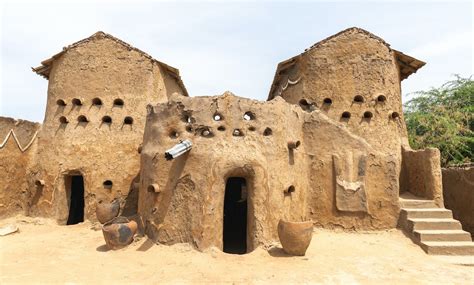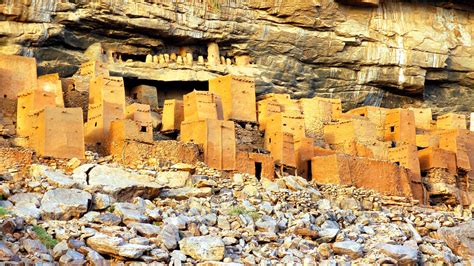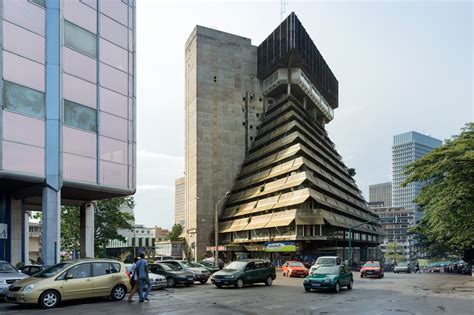Mankind has always held an unrelenting fascination for the dwellings that house various civilisations across the globe. In the realm of traditional African housing, one can discover a cornucopia of architectural marvels, each unique in its design, construction, and purpose. From the vast expanses of the Sahara to the lush plains of the Serengeti, Africa boasts a diverse tapestry of living spaces that intricately interweave cultural heritage, environmental adaptability, and social dynamics.
These indigenous abodes, often constructed from locally sourced materials, stand as testaments to the resourcefulness and ingenuity of the African people. Despite being overshadowed by modern structures in today's urban landscapes, traditional African dwellings retain an undeniable allure. They offer a glimpse into a bygone era and embody an intimate connection with nature, community, and ancestral traditions.
One cannot help but marvel at the exquisite craftsmanship found in the construction of these African homes. From the ornate detailing in the intricate carvings to the meticulous arrangement of thatched roofs, every aspect of these traditional abodes speaks volumes about the rich cultural heritage they represent. The respect for natural elements is evident in the choice of materials, such as clay, wood, grass, and stone, which not only blend harmoniously with the surrounding environment but also offer insulation, durability, and a sustainable way of life.
The diversity of traditional African dwellings is not only limited to their physical appearance but also extends to their functionality. Each dwelling is thoughtfully designed to cater to the unique needs of its inhabitants, taking into account factors such as climate, social structure, and prevalent traditions. From communal compounds that foster a sense of belonging to nomadic huts that allow for constant movement, these homes are reflections of a society's values, customs, and adaptability to the ever-changing world.
Mud Huts: The Quintessential African Dwelling

In the heart of Africa, a mesmerizing architectural marvel can be found: the mud hut. These traditional dwellings have stood the test of time and continue to captivate with their unique design and cultural significance. This article delves into the essence of mud huts, exploring their history, construction techniques, and the profound connection they have with African communities.
The Essence of Mud Huts
Embedded within the rich tapestry of African culture, mud huts embody the ideals of simplicity, resourcefulness, and harmony with nature. They are more than mere shelters; they are a reflection of the traditional way of life, the embodiment of communal values, and a tribute to ancestral wisdom.
Construction Techniques
The process of building a mud hut involves a delicate dance between man and earth. A framework of timber, bamboo, or reeds acts as the skeleton, while a mixture of mud, clay, and straw forms the ingenious mortar. This blend, carefully shaped and often embellished with decorative motifs, creates walls that are surprisingly sturdy and weather-resistant.
Architectural Features
Simple yet ingenious, mud huts showcase the practical ingenuity of African architecture. Their rounded or rectangular shapes maximize space utilization, offering cozy living areas and providing welcome respite from the scorching sun or chilly winds. The strategic placement of windows and vents allows for natural ventilation, and the use of thatched or grass roofs ensures thermal insulation.
Mud Hut Communities
These traditional dwellings are not mere structures but emblematic of the strong bonds that exist within African communities. Mud huts are often built as a collective effort, with entire villages coming together to share their skills and resources. The sense of unity and cooperation fosters a sense of belonging and creates spaces where stories are told, traditions are passed down, and dreams are woven.
Preserving Cultural Heritage
As modernization shapes the African continent, the significance of mud huts cannot be understated. While some may view them as relics of the past, they hold immense value as tangible links to Africa's cultural identity. Initiatives are underway to promote the preservation and celebration of mud huts, recognizing their role in fostering sustainable and resilient communities, as well as their potential to inspire contemporary architecture.
In conclusion, exploring the world of mud huts opens a window into the soul of Africa. These traditional dwellings capture the essence of African culture, showcasing the creativity, resourcefulness, and unity that define the continent. As we marvel at their beauty and significance, let us also strive to honor and preserve the heritage they represent.
Thatched Roofs: A Glimpse into Traditional Roofing Techniques
In this section, we will delve into the fascinating world of traditional African roofing techniques, specifically focusing on the charming craftsmanship of thatched roofs. These roofs, which are constructed using organic materials, have played a significant role in African architecture for centuries, and continue to showcase the ingenuity and resourcefulness of African communities in creating sustainable and resilient dwellings.
Ancient Wisdom Preserved: Thatched roofs have been utilized in various regions of Africa for generations, embodying the cultural heritage and wisdom passed down through the ages. The craftsmanship and techniques employed in thatching roofs have been refined over time, with each community adding its own unique flair and style to the process. These roofs serve not only as protection from the elements, but also as a symbol of tradition and identity, reflecting the values and beliefs of the people who live beneath them.
Environmentally Friendly Materials: Thatched roofs are constructed using natural and renewable materials such as straw, reeds, grasses, and palm leaves. These organic materials not only provide excellent insulation, keeping the interior cool in hot climates and warm in colder seasons, but also offer a sustainable alternative to more modern roofing materials. The use of locally sourced materials minimizes the environmental impact of the construction process and ensures the availability of resources for future generations.
The Art of Thatching: Building a thatched roof is a labor-intensive process that requires meticulous attention to detail and skilled craftsmanship. The organic materials are skillfully interwoven to create a durable and weather-resistant roof that can withstand harsh climatic conditions. The thatching technique varies across different African regions, with some communities using a layering method, while others opt for a bundling technique. Regardless of the specific technique used, the result is a visually stunning roof that seamlessly blends into the natural surroundings.
A Testament to Resilience: Thatched roofs not only showcase the artistry and craftsmanship of African communities, but also serve as a testament to their resilience and adaptability. Despite the increasing availability of modern roofing materials, many African communities continue to choose thatched roofs due to their durability, affordability, and cultural significance. These roofs withstand the test of time, standing as a living connection to the past and a beacon of sustainable living in the present.
In conclusion, thatched roofs offer a glimpse into the rich and diverse world of traditional African roofing techniques. They embody the cultural heritage, resourcefulness, and resilience of African communities, serving as a symbol of identity and sustainability. As we explore the fascinating intricacies of thatched roofs, we gain a deeper appreciation for the wisdom and craftsmanship that have been preserved for generations.
Adapting to Climate: How Indigenous African Homes Regulate Temperature

Understanding the ingenious methods traditional African dwellings employ to maintain comfortable temperatures in diverse climatic conditions offers a fascinating glimpse into the adaptability and resourcefulness of indigenous communities.
Natural insulation plays a crucial role in keeping these traditional homes cool in hot climates and warm during chilly seasons. Instead of relying on modern synthetic materials, local natural resources like straw, grass, or reeds are skillfully used in construction to create an effective barrier against extreme temperatures.
Ventilation and airflow are optimized in these dwellings to ensure efficient cooling and warmth circulation. Strategically placed windows, doorways, or openings positioned in alignment with the local wind patterns promote natural ventilation, allowing cool breezes to flow in and hot air to escape from the structure.
The thermal mass of the materials used in these traditional homes also plays a vital role in temperature regulation. Materials with high thermal mass, such as clay or adobe, can absorb and store heat during the day and release it slowly at night, providing warmth in cooler weather. Conversely, in hotter climates, the thermal mass helps to cool the interior by absorbing excess heat during the day and gradually releasing it during cooler evenings.
Precision in design and orientation is another critical factor in adapting to climate. Indigenous African architects and craftsmen have mastered the art of positioning their dwellings in harmony with the natural elements. Orientation towards prevailing winds, specific angles to maximize shade, and utilization of the surrounding landscape to provide natural protection against harsh weather conditions are all employed to great effect.
Shade and roofing techniques also play a significant role in temperature control within these traditional homes. Thatched roofs, often constructed with tightly layered grasses, create a natural barrier against direct sunlight, reducing heat absorption and maintaining a cooler indoor temperature. Additionally, exterior shading elements such as covered porches or verandas help to shield the structure from direct sunlight and provide additional space for occupants to enjoy cooler outdoor areas.
The sustainable adaptation to climate in traditional African dwellings serves as a testament to the deep connection indigenous communities maintain with their natural surroundings. By embracing eco-friendly construction techniques and utilizing locally available materials, these homes offer valuable lessons in energy-efficient design and provide a glimpse into a bygone era of environmental harmony.
Decorative Elements: The Artistry of House Designs in Africa
In this section, we will delve into the captivating and imaginative adornments that grace African house designs, showcasing the creativity and artistry embedded within each unique structure. From intricate patterns to vibrant colors, these decorative elements breathe life into the traditional dwellings found across the diverse landscapes of Africa.
The artistic flair that distinguishes African house designs stems from a deep-rooted cultural heritage that values storytelling, symbolism, and community connection. Each decorative element serves a purpose beyond mere aesthetics, with motifs and patterns often carrying significant meanings or conveying messages about the inhabitants' identity, history, or spiritual beliefs.
Across Africa, you will encounter a rich tapestry of decorative styles and techniques. From the geometric patterns adorning walls to the elaborate carvings adorning entryways, every aspect of African house design reflects the values and traditions of the people who call these dwellings home. Symbolic elements such as totemic animals, ancestral motifs, and intricate beadwork are often incorporated, offering glimpses into the cultural narratives that have shaped African communities for generations.
The use of color is another striking feature of African house designs. Bold and vibrant hues dominate the palette, ranging from earthy tones that harmonize with the natural surroundings to vibrant reds, blues, and yellows that create a visual spectacle. These colors not only add visual appeal but also serve as a means of expression, evoking emotions, and showcasing the boldness and resilience of African communities.
Furthermore, the materials used in African house designs contribute to their unique aesthetic appeal. From intricately woven thatch roofs to decorative mud plasters, the use of locally sourced and sustainable materials reflects the resourcefulness and ingenuity of African communities. These organic materials not only blend harmoniously with the natural environment but also ensure the longevity and resilience of the dwellings, standing as a testament to the creative adaptability of African architecture.
As we explore the artistry and decorative elements of African house designs, it becomes evident that these traditional dwellings are more than just shelters; they are vibrant embodiments of cultural heritage, communal identity, and artistic expression. Through their intricate patterns, vibrant colors, and storytelling motifs, African house designs offer a captivating glimpse into the rich tapestry of African cultures, where art and architecture intertwine in harmony.
From Tradition to Modernity: The Evolution of African Dwellings

In this section, we will delve into the transformation of African dwellings over time, highlighting the progression from traditional architectural designs to contemporary structures. Through the centuries, African communities have witnessed a shift in their housing styles and construction methods, adapting to the changing needs and influences of modernization.
1. Transformation of Materials: One notable aspect of the evolution of African dwellings is the change in the materials used for construction. While traditional homes were predominantly made of locally available resources such as mud, thatch, and stones, modern African architecture has incorporated new materials like concrete, cement, and metal. This shift in materials not only reflects advancements in technology but also addresses the demands of urbanization and population growth.
2. Influences of Western Architecture: The influence of Western architectural styles and techniques on African dwellings cannot be overlooked. With the arrival of colonial powers, African communities were exposed to new building methods and designs brought by Europeans. This fusion of traditional and Western architecture created a unique blend that can be seen in many contemporary African homes today.
3. Urbanization and Housing Challenges: As Africa's cities expand and populations continue to grow, there is an increasing demand for affordable and sustainable housing. This has prompted architects and urban planners to explore innovative solutions that integrate modern design principles with traditional elements. From high-rise buildings with traditional motifs to eco-friendly housing complexes, the evolving African architectural landscape is a response to the challenges of urbanization.
4. Preservation of Cultural Heritage: Despite the advancements in modern architecture, there is a growing recognition of the importance of preserving African cultural heritage. Efforts are being made to incorporate traditional architectural elements into modern designs without compromising functionality and aesthetics. This approach not only celebrates Africa's rich history but also ensures the continuity of cultural identity in a rapidly changing world.
Overall, the evolution of African dwellings represents a dynamic blend of tradition and modernity. As African societies navigate the complexities of development and progress, the architectural landscape serves as a testament to the resilience and adaptability of the continent's diverse cultures.
FAQ
Why are mud huts commonly used as dwellings in Africa?
Mud huts are commonly used as dwellings in Africa due to their affordability and availability of local materials. They help to maintain cool temperatures during hot weather and provide insulation during cold weather.
What are the advantages and disadvantages of living in a mud hut?
The advantages of living in a mud hut include affordability, natural insulation, and a connection to traditional African culture. However, disadvantages may include vulnerability to heavy rain or flooding, potential structural instability, and limited space for modern amenities.
Are mud huts still commonly used in Africa today?
Yes, mud huts are still commonly used in many rural areas of Africa today. They continue to be a practical and culturally significant choice for housing, especially in communities where modern construction materials may be expensive or hard to access.
What are some traditional building techniques used in constructing mud huts?
Traditional building techniques for mud huts include mixing mud with straw or other organic materials to strengthen the structure, using wooden frames or branches for support, and applying several layers of mud to create a sturdy and weather-resistant surface.
Can you describe the architectural features of a typical mud hut?
A typical mud hut in Africa may have a conical or rectangular shape, with a thatched roof made from grass or palm leaves. The walls are constructed from compacted mud or clay, often decorated with elaborate patterns or textures. The interior usually consists of a single room with a fireplace or hearth for cooking and warmth.



